With this Blog Post I’m reviving the tradition of having “themed” posts (the latest previous one was this) as well as reader polls about future themes (the last poll was at the bottom of this post). If you already want to know now what the new poll’s four choices are, scroll down to the bottom of this post, cast your vote, and then come back here.
For this post I randomly picked “trains” at the theme. Once again it will be mostly a photo essay with only the most essential background explanations.
The first thing about trains with a dark connection to spring to most people’s minds will be those deportation trains used by the Nazis to transport victims, mostly Jews, to the concentration camps and death camps during the Holocaust. It is hence not surprising that carriages from such trains feature in many Holocaust memorials/museums (Auschwitz alone has three in two separate locations). Here’s a photo of a set of such railway cars at a somewhat less well known site, the “Shoah Memorial” in Milan, Italy:

The Deutsches Technikmuseum (German Museum of Technology) in Berlin is mostly celebratory, but also doesn’t shy away from the dark topic of deportation trains and has a section about it with a rail carriage at its centre, and you can even enter it:

At the old Radegast station in Łodz, Poland, a whole train consisting of four such carriages and a large grey steam locomotive form part of today’s sobering memorial at the site:
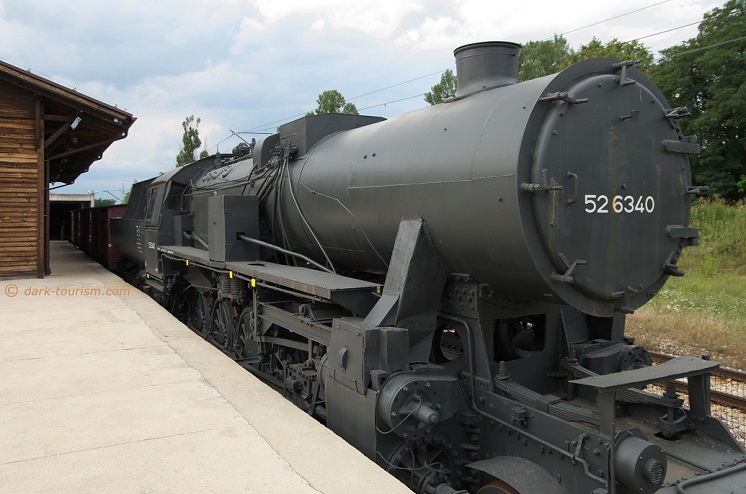
Deportation trains were not just used by the Third Reich, in a similar way deportees were also carted off to the gulags in Siberia and elsewhere in the Soviet Union especially during Stalin’s reign of terror. In the former Soviet republic of Kazakhstan is a memorial for the ALZHIR camp that stood at the village of Malinovka (aka Akmol), and this too features a deportation train cattle car:

Another dark association with trains that comes to mind is those trains that rode the infamous “Death Railway”, aka Thailand-Burma Railway, constructed for Imperial Japan during WWII with most of the hard manual work done by Allied POWs, i.e. by forced labour. It’s one of the darkest chapters of this grim period in Japan’s history. Yet at the Yushukan war museum in Tokyo, the Death Railway is celebrated as a great technological feat, with no mention of POWs and atrocities, with the first steam engine that rode that railway line on display in the large foyer of the museum, i.e. in an especially prominent place:

Part of the Thailand-Burma Railway line is still in existence and a section at its Thai end is even still in use, though these days obviously with more contemporary trains/carriages. It’s now mostly for tourists and I rode it as part of my Indochina trip many years ago, namely from Kanchanaburi (with the famous Bridge on the River Kwai, which the train crossed) to the current end of the line. At a particularly spectacular stretch I took this photo (note the guy precariously hanging out of the train to take a snap – this was all before smartphone cameras and those horrible selfie sticks came along):

Trains can also be dark due to train disasters, of course, and the very worst one ever involved the train “Queen of the Sea” during the Boxing Day Tsunami of 2004 in Sri Lanka. The waves crushed and drowned the train and its passengers, claiming nearly 2000 lives. Today a single carriage survives as a memorial near the site of the disaster:

In contrast, the next rail carriage to feature here is completely intact and has a totally different dark association – namely that it was Stalin’s special (and armoured) private carriage which he travelled about in during his reign (he was allegedly afraid of flying, so he did all journeys rather by train). After his death the carriage ended up as a star exhibit at the Stalin Museum in his birthplace of Gori in Georgia:

Speaking of the communist era, building train lines was a prestige thing at that time, not just in the Soviet Union (with the Trans-Siberian Railway the most ambitious), also in other communist states within the Eastern Bloc sphere, e.g. the ČSSR. One such project was the construction of the so-called Railway of Youth, for which thousands of allegedly enthusiastic young workers volunteered in the late 1940s. Today there is still an exhibition about the Railway of Youth at one of its stations, namely in Banska Stiavnica in what today is Slovakia:

Staying with the communist era, here’s a photo of another special train, this time from the GDR, namely one taken at a cell inside the so-called “Grotewohl Express” for transporting political prisoners. This carriage is now on display at the impressive memorial at the former Stasi prison of Hohenschönhausen in East Berlin:
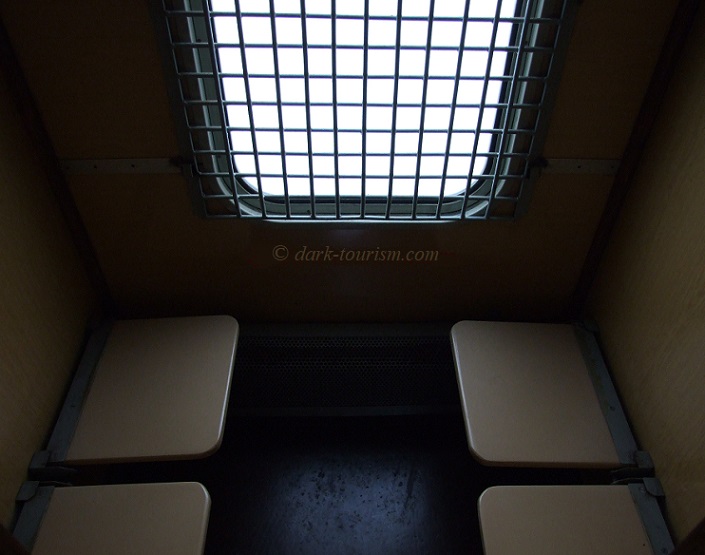
Also in Berlin, but in the West, a train carriage used by one of the Western Allies on the other side of the Iron Curtain, namely by the French military, I found on display at the AlliiertenMuseum:

Also note in this photo the original Checkpoint Charlie hut that was taken here after the Fall of the Berlin Wall. The smaller hut found at the original location now where so many thousands of tourists have their photo taken (or take a selfie these days) is only a bad replica. The rail carriage was used to take French officials from West Germany through GDR territory into West Berlin, so in a way it had to cross the Iron Curtain twice en route!
A very different, and much, much darker relic of the Cold War is this train on display at the former Soviet missile base of Pervomaisk in Ukraine:
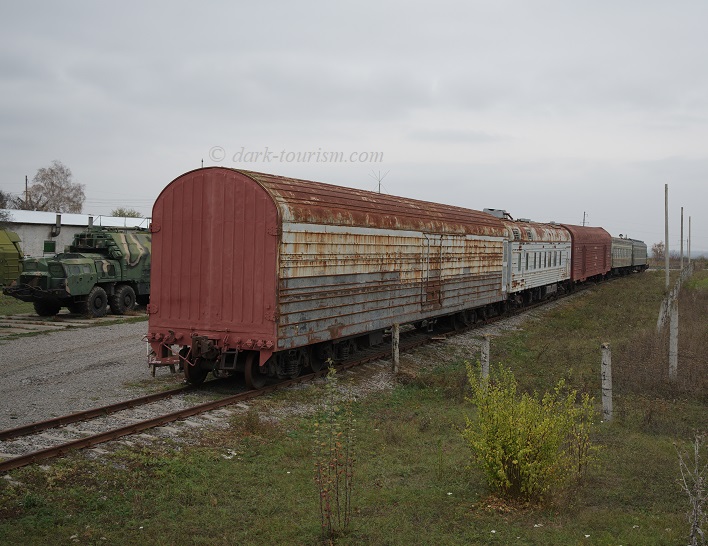
The long rusty carriages at the end and middle of this train used to carry ICBMs (intercontinental ballistic missiles) which could be launched from the carriage within minutes, and being mobile they were hard to locate. Such mobile systems are still in operation in Russia, as far as I know.
A rather different relic from the Cold-War era is Gaustabanen in southern Norway. This was constructed as a 45-degrees diagonal tunnel inside the Gausta mountain for narrow-gauge little trains to take personnel to a NATO radio tower at the top of the mountain. Today you can ride this bizarre train as a tourist:

And here’s another train inside a mountain, this time the Jungfraujoch in Switzerland; the photo shows the train at the terminus at nearly 3500m (11,400 feet) elevation:

The construction of this high Alpine railway was extremely demanding, and there were several deadly accidents in the process, hence the dark association even with this Swiss train.
Trains also play a role in mining, usually narrow gauge and with low engines and carriages that are rarely seen in the open air. Here’s an exception: a duo of mining trains that were used in the nearby uranium mines at the Czech forced labour camp of Vojna from the darkest communist era. It is now a memorial:

Uranium is a keyword for the dark-tourism subcategory of “nuclear tourism” of course. And one of the pinnacles of this branch of DT used to be visiting Chernobyl in Ukraine, now no longer possible due to Russia’s war of aggression against this country. When I last went, in winter in late 2018, I arrived in a more unusual way compared to the typical coach tours that most tourists used, namely by commuter train, together with all the workers at the Chernobyl NPP, from the small town of Slavutych. Here’s a photo of one such train at the terminus in Chernobyl:

I don’t know whether these trains currently still operate. I know that the people of Slavutych repelled the Russian aggressors and the Russian military left Chernobyl after their aborted initial conquest at the beginning of the invasion. But a long part of the train line goes through the territory of Belarus. Whether that is still possible is unclear. What is clear is that there are currently no longer tourist trips to Chernobyl, with many former guides probably serving at the front right now, and whether Chernobyl tourism will resume when the war ends (which it hopefully does before too long), and if so in what form, is anybody’s guess.
Another effect of the war is that former Russian gas and oil supplies have ceased for several Western countries (or rather were severed by Western countries like Germany). Here’s a picture from the past, when long oil trains passed through Riga, Latvia:

The last time I went to Russia was in 2017 (and now it’s rather unlikely that I’ll ever go back there …. unless things change dramatically for the better). I had previously been in 1999 and I also added a short side trip to my Norway itinerary in 2012, going from Kirkenes to Murmansk in the north. In Murmansk I spotted this long train full of coal from the mines of the region:

Apart from where this photo was taken there is the added dark element that coal is about the dirtiest of the fossil fuels the world still burns despite the climate crisis.
A completely different sort of dark association comes in the following photo of a propaganda poster in Pyongyang, North Korea, which I took way back in 2005:

This is totally over the top in more than one way. The typical depiction of children enthusiastically admiring Kim Il-Sung (aka the Great Leader) and his son Kim Jong-Il (aka the Dear Leader) is as kitschy and unrealistic as it can get. But the fact that they are in/at a Japanese-style bullet train mock-up is even crazier. Of course there have never been any bullet trains in North Korea – and that they would copy a design from the country’s arch-enemy Japan beggars belief.
This wasn’t the only time I encountered a totally unrealistic depiction of a bullet train. They also featured on the pillowcases in the overnight train from Baku, Azerbaijan, to Tbilisi, Georgia in 2010:

Just for comparison, here’s a photo I took from that train the next morning:

As you can see, it’s nothing like a bullet train but a bog-standard typically Eastern Bloc train. A plaque in the corridor actually specified that the carriages had been built in the GDR, which is also an indication of how old they must be.
Also just for comparison, here’s what a genuine modern bullet train (Shinkansen) looks like in Japan:

A rather special niche area of dark tourism involving trains is train graveyards. And one of the most famous is the train graveyard at the Uyuni salt flat high in the Andes in Bolivia, where dozens of old steam trains are assembled and slowly rusting away:
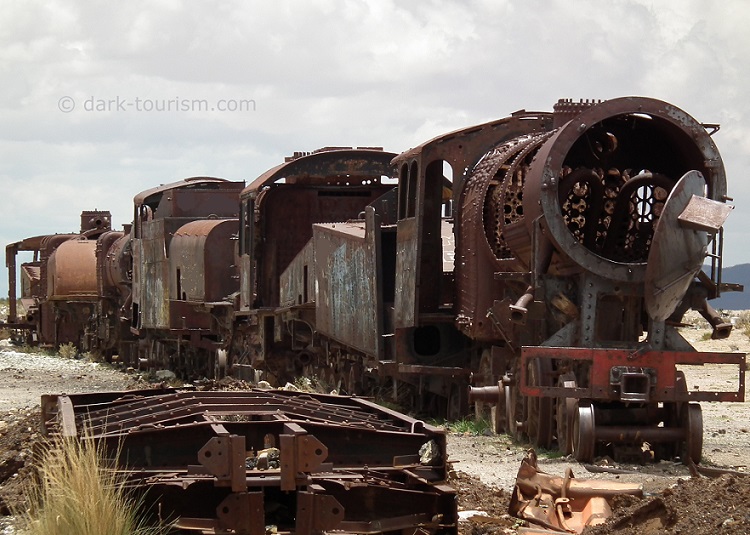
Finally, here’s a photo of another abandoned train, this time with a wooden carriage, which I also found, stranded at the Bolivia–Chile border crossing on my way back to Calama (same photo as the featured one at the top of this post):
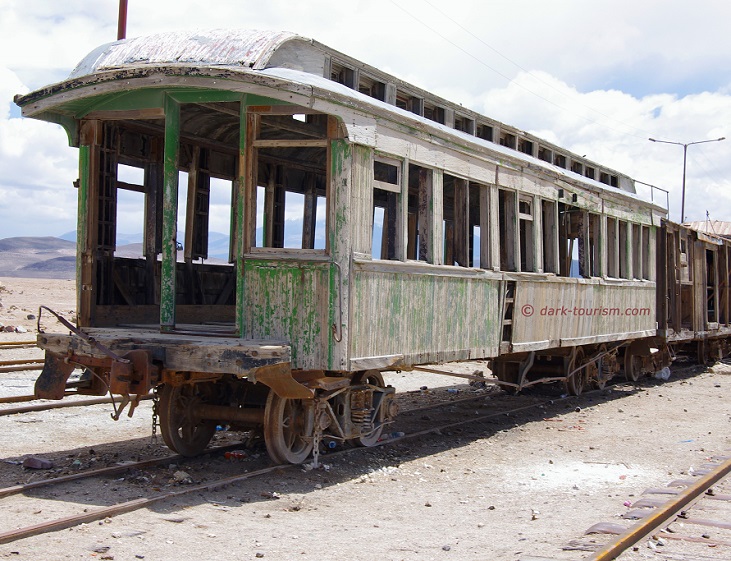
But so much for the theme Dark Tourism & Trains – I hope you’ve enjoyed it.
Now to the theme poll that I promised at the beginning of this post. As before I’ve chosen four themes for you to choose from, all beginning with <b>; one or two have featured in previous polls (where they didn’t make it and are hence given another chance now), the others are all-new ideas:
a) Dark Tourism & Bent Steel
b) Dark Tourism & Barbed Wire
c) Dark Tourism & Books
d) Dark Tourism & Beds
Please cast your vote by submitting a comment below – or if you are a subscriber to the DT Newsletter (see top of the page for subscribing) then you can also send your vote by replying to the latest Newsletter email. I’m intrigued how it will go …
UPDATE: this poll is now closed and the winning theme, DT & books, has been posted.




21 responses
that will be a C from me Peter…books
thanks! Noted
I also vote C!
thanks, noted
Sure why not. I vote for C also.
Great post on the trains !!!
thanks – I quite liked it myself.
And your vote’s been counted.
Nice article about the trains – very diverse…
My vote is for beds – mostly because I don’t really know what to expect, and that makes me curious…
thanks! I’m quite fond of it too …. for the same reason.
And your vote’s been counted.
Beds please!
noted!
Hi Peter, what a fascinating article! I vote for books.
thanks! Your vote’s been counted …
Books!
thanks, noted.
Great blog. Books please!
many thanks! And your vote’s been noted.
In my travels around the world I have visited many developing countries. As a feature of these trips beds were very important. However a well earned nights sleep was not always guaranteed, noisy air con units, bugs or plain uncomfortable beds too regularly failed to provide the much needed rest. Sometimes all three together. The worst? Hotel de la Poste, St Louis, Seneagal. So, beds for me…..
well argued case – and your vote’s been noted – though the beds I have lined up for that theme do not include any I’ve used myself … and have much darker connections than mere discomfort …
We were fortunate to visit Robben Island some years ago and see first hand Nelson Mandelas cell and bed, the whole experience very thought provoking
As a bookworm (although I much prefer the German term “Leseratte”), I was tempted to follow the herd and go for DT & Books, but then my “always side with the underdog” attitude kicked in so DT & Beds gets my vote in this poll. S x
;-)))))
noted